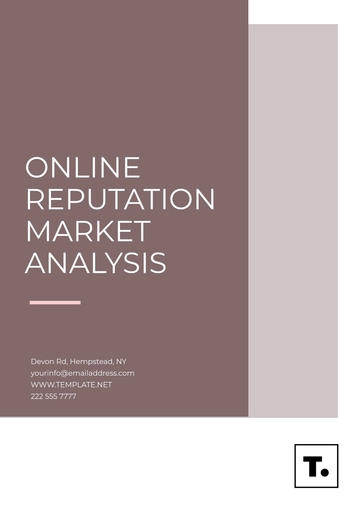Free Printable Market and Competitive Analysis

I. Introduction
In today’s dynamic business environment, understanding market trends and competitive landscapes is crucial for strategic decision-making. [Your Company Name] recognizes the importance of comprehensive market and competitive analysis as a foundational component of our growth strategy. This report aims to provide a thorough examination of current market conditions, key industry players, and emerging trends. By analyzing these factors, we seek to identify opportunities for growth and areas where we can leverage our strengths to gain a competitive edge.
Our analysis covers a range of elements, including market size, growth projections, consumer behavior, and competitive positioning. We will delve into the profiles of major competitors, assess their market strategies, and highlight their strengths and weaknesses. This will enable us to make informed decisions, anticipate market shifts, and adapt our strategies to align with industry trends. At [Your Company Name], our goal is to ensure that our strategic initiatives are well-informed and aligned with market realities, positioning us for sustained success in an increasingly competitive landscape.
II. Market Overview
Understanding the market landscape is essential for recognizing opportunities and challenges within the printing industry. This section provides an in-depth overview of the market, including its definition, segmentation, and growth dynamics. We will explore the diverse range of products and services available, from printers and inks to print services, and break down the market by various criteria such as application, technology, and region.
By examining market size, growth trends, and key drivers, we aim to offer valuable insights into the factors shaping the industry. This comprehensive analysis will highlight the potential for growth and areas of concern, equipping [Your Company Name] with the knowledge needed to navigate the evolving market landscape effectively.
A. Market Definition
The market encompasses a wide range of activities and services aimed at promoting and selling products or services. This includes strategic planning, market research, advertising, public relations, digital marketing, and sales promotions. It involves creating and executing campaigns to reach target audiences through various channels such as social media, email, television, and print.
This is essential for businesses of all sizes and industries, as it drives customer engagement and business growth. By employing different marketing strategies and techniques, companies can effectively communicate their value propositions and differentiate themselves in competitive markets.
B. Market Segmentation
Understanding market segmentation is crucial for tailoring marketing strategies to meet the specific needs of different customer groups. By breaking down the market into distinct segments, businesses can focus their efforts on the most promising areas and design targeted campaigns that resonate with each audience. This approach allows for more effective allocation of resources and enhances the overall impact of marketing initiatives.
The table below provides a clear overview of the primary market segments in the marketing industry. It outlines the segmentation criteria based on product type, application, technology, and region, offering valuable insights into the various components and dynamics of the market. This detailed breakdown will help in identifying key areas for growth and strategic focus.
Segmentation Criteria | Categories |
|---|---|
By Product Type | Marketing Strategy, Market Research, Advertising, Public Relations, Digital Marketing, Sales Promotions |
By Application | B2B (Business-to-Business), B2C (Business-to-Consumer), C2C (Consumer-to-Consumer) |
By Technology | Traditional Media, Digital Media, Social Media, Content Marketing |
By Region | orth America, Europe, Asia-Pacific, Latin America, Middle East & Africa |
C. Market Size and Growth
The global market has been experiencing steady growth due to increased demand for printing solutions across various sectors. The following table highlights the market size and growth rate over recent years:
D. Market Drivers
Several key factors are fueling growth in the marketing industry, shaping its trajectory and driving innovation. One major driver is the rapid advancement in digital technologies, which enables more precise targeting and personalized marketing efforts. The rise of data analytics and AI tools allows businesses to gain deeper insights into consumer behavior, optimize campaigns, and improve ROI. Additionally, the proliferation of digital and social media platforms provides new channels for reaching audiences, enhancing engagement, and driving brand loyalty.
Another significant driver is the increasing demand for data-driven marketing strategies. Companies are prioritizing data collection and analysis to make informed decisions and measure campaign effectiveness. The growing emphasis on customer experience and personalization also pushes businesses to adopt advanced marketing techniques that cater to individual preferences. Overall, these drivers are reshaping the marketing landscape, creating opportunities for companies to innovate and stay competitive.
Technological advancements in digital marketing tools
Increased focus on data analytics and AI
Expansion of digital and social media platforms
Rising demand for personalized and targeted marketing
Growing emphasis on customer experience and engagement
E. Market Challenges
competition among businesses often leads to saturated markets, making it difficult for companies to stand out and capture consumer attention. Additionally, rapidly evolving technologies and consumer preferences require constant adaptation, which can strain resources and complicate strategy development.
Another challenge is the increasing scrutiny over data privacy and security, necessitating stringent compliance with regulations.
High market competition
Evolving technology and consumer preferences
Data privacy and security concerns
III. Competitive Analysis
In a competitive landscape, understanding the strengths and weaknesses of key players is essential for developing effective strategies. Analyzing competitors helps identify opportunities for differentiation and areas where improvement is needed. By evaluating their market positioning, strategies, and performance, businesses can gain insights into industry trends and benchmark their own efforts.
The table below provides a structured overview of major competitors in the marketing industry. It highlights their key attributes, including market share, primary services, strengths, and weaknesses. This comparative analysis offers valuable information to guide strategic decisions and identify areas for competitive advantage.
Competitor | Market Share | Primary Services | Strengths | Weaknesses |
|---|---|---|---|---|
Competitor A | 25% | Digital Marketing, SEO, Content Creation | Strong brand presence, Advanced analytics | High service costs, Limited regional reach |
Competitor B | 20% | Social Media Management, Advertising | Extensive network, Creative strategies | Poor customer support, Slow response times |
Competitor C | 15% | Market Research, PR, Event Management | In-depth industry expertise, Wide range of services | High staff turnover, High operational costs |
Competitor D | 10% | Email Marketing, PPC Advertising | Cost-effective solutions, Robust reporting tools | Limited scalability, Basic service offerings |
D. SWOT Analysis
Below is a SWOT analysis for the top competitor, Competitor A:
Strengths | Weaknesses |
|---|---|
|
|
Opportunities | Threats |
|
|
IV. Market Trends
Understanding market trends is essential for adapting strategies and staying competitive in the ever-evolving marketing landscape. This section delves into key trends that are currently shaping the industry, providing insights into emerging technologies, consumer behaviors, and strategic shifts.
A. Artificial Intelligence and Machine Learning
Artificial Intelligence (AI) and Machine Learning (ML) are transforming the marketing industry by enhancing data analysis, automation, and personalization. AI-driven tools such as chatbots are improving customer service by providing instant, accurate responses. ML algorithms are used to analyze large datasets, predict consumer behavior, and optimize marketing strategies. These technologies enable more targeted advertising, efficient resource allocation, and personalized user experiences, leading to higher engagement and conversion rates.
B. Customer Experience and Personalization
Today’s consumers expect personalized interactions and tailored experiences. Companies are leveraging data analytics to deliver customized content, recommendations, and offers that align with individual preferences. This focus on personalization enhances customer satisfaction and loyalty, making it a key competitive advantage. Marketing strategies now prioritize creating unique customer journeys, leveraging insights from customer behavior and feedback to improve interactions across various touchpoints.
C. Social Media Evolution
Social media continues to be a dominant force in marketing, with platforms constantly evolving to offer new features and engagement opportunities. Brands are moving beyond basic social media presence to engage in more strategic activities, including influencer partnerships and interactive content. Real-time engagement through social media allows brands to respond quickly to trends, gather customer feedback, and build strong community relationships. The rise of new platforms and features requires marketers to stay agile and creative in their social media strategies.
D. Sustainability and Corporate Social Responsibility (CSR)
Sustainability and CSR are increasingly important to consumers, influencing their purchasing decisions. Companies that demonstrate a commitment to ethical practices, environmental responsibility, and social causes are gaining favor with the growing segment of socially conscious consumers. Integrating sustainability into marketing strategies not only enhances brand reputation but also aligns with the values of a more environmentally aware and socially responsible audience.
By keeping abreast of these trends, businesses can adapt their marketing strategies to better meet evolving consumer expectations and leverage new opportunities for growth.
V. Strategic Insights
Uncovering strategic insights is crucial for navigating the marketing landscape and leveraging growth opportunities. By identifying key market opportunities and formulating actionable recommendations, businesses can enhance their competitive position and drive success. This section provides a comprehensive overview of potential areas for expansion and innovation, alongside targeted strategies to capitalize on these prospects. Understanding and acting upon these insights will enable companies to effectively address market demands and achieve their strategic objectives in a dynamic and evolving industry.
A. Market Opportunities
Identifying market opportunities is essential for leveraging growth potential and gaining a competitive edge. Here are key opportunities currently available in the marketing industry:
Expansion into Emerging Markets: Many developing regions are experiencing rapid economic growth and increased internet penetration. Expanding into these markets can offer substantial opportunities for growth, particularly in digital marketing and e-commerce.
Advancements in Digital Advertising: Innovations in digital advertising, such as programmatic buying and real-time bidding, present opportunities for more efficient and effective ad placements. Leveraging these technologies can enhance targeting precision and optimize marketing spend.
Growth of Influencer Marketing: The continued rise of social media influencers provides a unique avenue for reaching targeted audiences through authentic and engaging content. Partnering with influencers can boost brand visibility and credibility.
Demand for Sustainable Practices: As consumers increasingly prioritize sustainability, incorporating eco-friendly practices into marketing strategies can appeal to environmentally conscious customers and strengthen brand loyalty.
Personalization and Data Analytics: Enhanced data analytics and AI-driven personalization offer opportunities to create highly tailored marketing campaigns. By utilizing advanced analytics, businesses can better understand consumer behavior and deliver more relevant content.
B. Recommendations
To capitalize on these opportunities, consider the following strategic recommendations:
Invest in Market Research: Conduct thorough research to understand the needs and preferences of emerging markets. Tailor marketing strategies to align with local cultures and consumer behaviors to maximize impact.
Adopt Advanced Digital Advertising Technologies: Implement programmatic advertising and real-time bidding to optimize ad placements and improve ROI. Stay updated with the latest digital advertising trends to remain competitive.
Leverage Influencer Partnerships: Identify and collaborate with influencers who align with your brand values and target audience. Develop authentic and engaging campaigns to enhance brand awareness and customer trust.
Integrate Sustainable Practices: Incorporate sustainability into your brand’s core values and marketing messages. Highlight eco-friendly initiatives and practices to attract and retain environmentally conscious consumers.
Enhance Personalization Efforts: Utilize data analytics and AI to deliver personalized marketing experiences. Invest in technologies that enable dynamic content delivery and targeted messaging to increase engagement and conversion rates.
VI. Conclusion
This market and competitive analysis has provided a detailed examination of the trends, key players, and growth opportunities within the marketing industry. The insights reveal significant advancements in technology, shifts in consumer expectations, and emerging market dynamics that are shaping the future of marketing. By understanding these factors, businesses can better navigate the complexities of the market and align their strategies with current trends.
Stakeholders are encouraged to utilize the findings from this analysis to make informed decisions and enhance their competitive positioning. Embracing these insights will enable companies to capitalize on new opportunities, address challenges effectively, and drive sustained growth in a rapidly evolving industry.
- 100% Customizable, free editor
- Access 1 Million+ Templates, photo’s & graphics
- Download or share as a template
- Click and replace photos, graphics, text, backgrounds
- Resize, crop, AI write & more
- Access advanced editor
Stay ahead of the competition with the Printable Market and Competitive Analysis Template from Template.net. Fully customizable and editable, this template provides a comprehensive format for analyzing market trends and competitor strategies. Editable in our AI Editor Tool, it ensures your analysis is detailed, professional, and ready for print, helping you make informed business decisions.





























